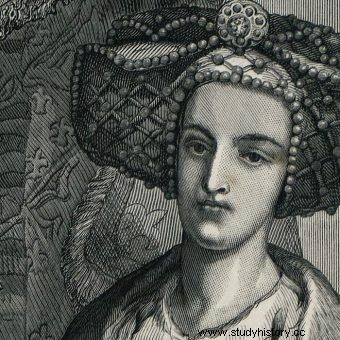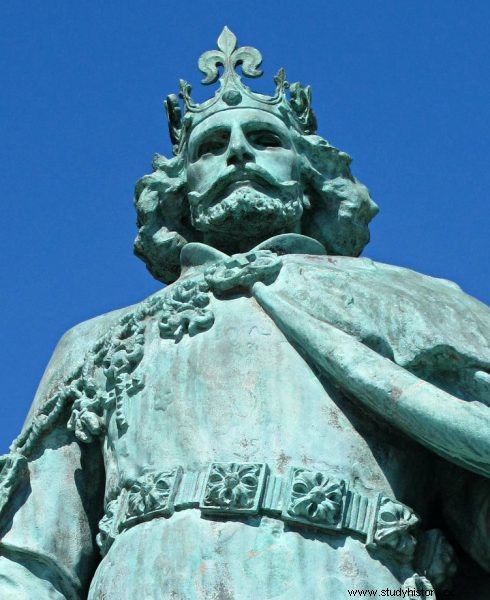She never visited Poland, and after her husband's death, she led to a devastating civil war on the Vistula River. Inept, demanding and self-righteous. How did she become a Polish queen at all?
The rule of Elżbieta Bośniaczek did not bring Poland anything good. It was she who, after the death of her husband Ludwik Węgierski in 1382, began to throw logs at her daughter's feet. That is why little Jadwiga Andegaweńska did not come to the Vistula River, the country plunged into destructive battles and many years of anarchy accompanying the first, great interregnum. It was close, and Jadwiga would lose all hope for the crown and the future, just because her mother could not come to terms with any competition. Even from your child.

Elżbieta Bośniaczek as imagined by Jan Matejko
How did such a vain and inept woman come to sit on the throne of Hungary and decide the fate of one of the greatest empires in Europe - including not only the crown of Saint Stephen, but also Poland and Red Ruthenia?
Warrior King
Ludwik Anjouski's second marriage was born out of fear. Its sources can be found more than thirty years earlier. In 1348 the king was only twenty-two years old, but he was already considered a man laughing in the face of death.
The crowned youth hunted big game with great passion, and at least once he was almost torn to shreds by a rabid bear. His courtiers saved him at the last minute, but the next time he might not be so lucky. He also took a risk in wars. He was unable to sit still at home.
He conducted new campaigns virtually every year, often without a good pretext or political plan. He loved the warrior itself. And, of course, he wasn't content with leading from the third line. He always had to be at the forefront, where the blood was shed, where the screams of the wounded pierced the air ... Where the adrenaline rush gave a kick, without which Ludwik was unable to live.

Louis the Great. Statue in Heroes' Square in Budapest
He wasn't afraid for himself. Fear filled the thoughts of his mother - Elżbieta Łokietkówna, who came from Poland. Elizabeth began to gain a prominent position at the Hungarian court during the life of her sickly husband. When her teenage son took power in 1342, she became an unofficial co-regent. It made the most important political decisions, influenced the verdicts of the courts, controlled thousands of officials and managed a fabulous estate. She looked after everything, often to a greater degree than the king himself. And only the impetuous Ludwik was not able to control.
The specter of an epidemic
Times were not conducive to bravado. In 1348, the Black Death arrived in Europe - a devastating plague that will soon kill up to a third of the continent's population. When the epidemic hit Italy, killing up to 50,000 people in Naples itself and its vicinity, Louis was there on one of his military expeditions. Returning to his country, he also brought the plague with him.
Here, at least, the plague did not spread as forcefully and as fast as in Western Europe, but the dead bodies were still hard to count. In 1349, mainly peasants, inhabitants of the province, died. However, the disease attacked again, this time taking city dwellers and representatives of the highest elite. In 1359, you hear about the sudden death of "many famous barons". The losses are so great that Ludwik and Elizabeth have to reorganize the clerical ladder. There is a shortage of the right people to fill the most important positions. The provincial governor of Transylvania, the court judge, the master of taverns, the royal cup-maker are dying almost simultaneously ... Most of them are people with whom the king and queen come into contact almost every day. Then the Black Death may come after them too ... And thus - for the entire dynasty, because Ludwik has no descendants.
The king's wife, Margaret of Luxemburg, dies of the plague the first time the plague hits it, in 1349. She is only fourteen years old and it is not even known whether her marriage to Ludwik was consummated. The rebirth of the king becomes of utmost importance. Elizabeth does not intend to leave anything to chance. She is looking for a candidate that she will be able to form personally, add to herself and educate in such a way that she will be a support, not a burden for Ludwik. The choice falls on her namesake:Elizabeth called the Bosnian girl.
Candidate for the new queen
The girl was ten in 1350 and she owed her very existence to the Hungarian queen. On the occasion of the famous Visegrad congress - this congress at which the Polish king Kazimierz spent a fortune to buy back the rights to the Polish crown and thus end the many years of quarrels with Luxembourg - another, slightly forgotten decision was made. To strengthen mutual relations, Kazimierz and Elżbieta decided to enter into a mutually beneficial political marriage.

Queen Elizabeth of Bosnia in the company of her daughters. Bas-relief on the reliquary in Zadar
The Polish king did not have any sons or daughters, but he did have vassals and loyal allies. Also, Elizabeth's husband Karol Robert had many dependent princes. A few months before the congress, one of them, a ban (and therefore the ruler) of Bosnia, Stefan II Kotromanić, was married to a Kujawy princess from the side line of the Piast dynasty, Elżbieta of Gniewkowo. It was from this union, mediated by Łokietkówna, that Elżbieta Bośniaczka was born. She was half Polish and it certainly did not escape the attention of the Hungarian queen. She invited a girl, who was supposedly known (apparently because it is a message rather devoid of any source foundations) of exceptional beauty, to her court and began to prepare her for the role of the future ruler.
The Bosnian girl became Elizabeth's most important pupil. But she was by no means the only one. In the monastery of Poor Clares that she founded in Buda, the Queen ran an unofficial school for aristocrats. It was known all over the country how well she put together her sons, what discipline, knack, and class she instilled in them. Hungarian fathers and mothers dreamed that their children would be as loyal and talented as Ludwik. And if only their position and property allowed them, they gave their own descendants under the wings of the learned queen. Elżbieta dealt with them just like any of her projects - with absolute dedication. And when it came to important students, she did not even shy away from dirty tricks and bribes, just to encourage them to spend time reading books. When her sister's granddaughter, Kunegunda, Princess of Opole, came to the convention, Elżbieta gave her half of a mill. The princess was allowed to derive income from it, but only on the condition that ... she stayed in the convent.

Elżbieta Łokietkówna in the vicinity of the manor house in the graphics of Fr. Pillati
The wealthy queen sincerely believed that everything could be bought at the right price. Likewise, she constantly offered generous "alms" to the Poor Clares, believing that it would bring her absolution and a reward in heaven. Did she also buy her future daughter-in-law, Elizabeth of Bosnia? We don't know that, but she must have cast an equally tight net on it as it does on her always faithful and submissive son.
The Bosnian woman was constantly punished, silent and obedient. And she understood that she owed everything to the queen mother. Her wedding to Louis took place on June 20, 1353. The girl was thirteen. In the following years, it was still suppressed and ignored. Some mediaists even doubt whether the Bosnian woman received her own separate court. She was a painted, absolutely passive queen.
Certainly, the young monarch did not play any political role. And when in 1370 Louis, mainly thanks to the efforts of his mother, sat on the Polish throne, the Bosnian women were neither crowned Polish queen, nor even invited to the Vistula River. Elżbieta Łokietkówna did not want any competition. She personally took power in Krakow and she called herself the Queen of Poland. And her namesake? All that was left to do was waiting. Until finally the mother-in-law and husband will die and she will be able to spread her wings, proving her own worth ...
***
One article is far too little to describe the turbulent history of Hungary and Poland during the reign of the forgotten Anjou dynasty. Learn much more about Ludwik Andegaweński, his ambitious mother, Elżbieta Łokietkówna and about Elżbieta Bośniaczka in my new book: We will give the Polish empire. The Women Who Built a Power " .
Selected bibliography:
The article was based on materials collected by the author during the work on the book "Ladies of the Polish Empire. The Women Who Built a Power " . Some of these items are shown below. Full bibliography in the book.
- Dąbrowski J., Elżbieta Łokietkówna 1305-1380 , Universitas, Krakow 2007.
- Dąbrowski J., The last years of Ludwik the Great 1370-1382 , Universitas, Krakow 2009.
- Engel P., The Realm of St. Stephen. A History of Medieval Hungary 895-1526 , I.B. Tauris, London-New York 2001.
- Lendvai P., Hungarians. A thousand years of victories in defeats , International Cultural Center, Krakow 2016.
- Sroka S.A., Elżbieta Łokietkówna , Homini, Bydgoszcz 1999.
